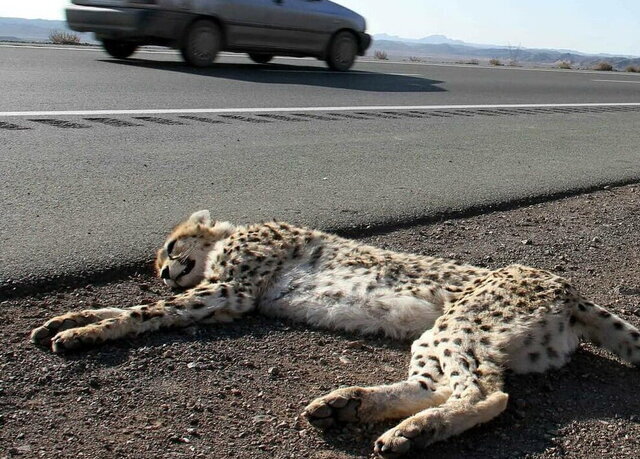Roads against wildlife

TEHRAN – Some 50 percent of wildlife deaths and 52 percent of Asiatic cheetah deaths are caused by road accidents, an expert at the Department of Environment has said.
A total of 38 cases of Asiatic cheetah deaths have been recorded, of which 19 were due to road accidents, and eight of them were related to the Abbas-Abad road, ISNA quoted Marzieh Mousavi as saying on Monday.
Six cases occurred on the Yazd-Kerman road. There was one case on the Bafq-Bahabad road, one case on the Senkhast-Jajaam road, one case in Kerman province, and one case on the Naybandan road, she explained.
Turan National Park is a breeding area and an important habitat for cheetahs, that's why the most casualties were related to this road. Years ago, road crashes killed the species on the Kalmand-Bahadran road, but due to the inexistence of cheetahs in the area, no deaths are recorded anymore.
According to this report, 52 percent of cheetah deaths are related to road crashes, and traffic accidents are reported to be the cause of half of all wildlife deaths.
It can be said that roads are a potential threat to wildlife and if the situation continues in this way and the Ministry of Transport and Urban Development expands the road network without environmental assessment, casualties will increase and many species will be lost, she lamented.
Referring to the species of leopard that has a mountain habitat, she said that this species is less exposed to road accidents, however, 25 percent of leopard deaths were related to road accidents.
She considered carnivorous species to be more vulnerable to road accidents and added that they are more damaged than herbivores due to moving between habitats to find prey.
All the eight species of cats in Iran, such as the Pallas cat, jungle cat, wild cat, etc., are damaged by roads. Even the sand cat, which has a desert habitat and is not exposed to roads, is also exposed to traffic accidents, she said.
DOE’s actions to reduce wildlife road casualties
To the extent possible, the DOE opposes the construction of new roads, especially those that pass through protected areas, and consults with relevant institutions such as the Ministry of Roads and Urban Development, Mousavi noted.
Also, it identified the hot spots of road casualties and urged the relevant departments in each province to secure the road for wildlife to pass through.
At present, small signs do not have the required efficiency, while according to the written instructions, the signs should be prepared based on international standards and be visible, and the installation of speed control cameras and road safety should be implemented based on these standardized protocols, she stated.
In this regard, the Ministry of Roads should also provide assistance and credit for this issue, and before building the road, it should take environmental considerations into account and take necessary measures in places where overpasses or underpasses are needed.
It is not expected such measures to be taken for all roads, but currently, even on Abbas Abad road, which is the habitat of cheetahs and endangered species, we have not succeeded in building an overpass or underpass and securing the road for animals to pass, she said.
In many cases, we try to carry out evaluation and environmental considerations, but sometimes this does not happen, and after the work is completed, the newly-constructed road will not change and modify, she lamented.
Persian species in danger
Iran has a high diversity of species due to geographical conditions, climatic diversity, huge water resources of the Caspian Sea in the north and the Persian Gulf, and the Sea of Oman in the south.
According to the latest studies, about 1,300 species of vertebrates, including mammals, birds, reptiles, amphibians, and aquatic fish, about 30,000 species of invertebrates, and 8,000 species of plants have been identified in the country.
Unfortunately, over the past two decades, human activities have led to the alarming degradation of ecosystems, and the deletion of genes, species, and biological capabilities; Human threats to biodiversity have accelerated the most over the past 50 years over the entire history of human life.
Out of 1,300 species of animals in the country, 130 of which are endangered and threatened, Hassan Akbari, deputy head of natural environment and biodiversity of the Department of Environment, said in December 2021.
According to the IUCN, at least 40 percent of animals, insects, and plants are at risk of extinction across the world.
Currently, more than 41 percent of amphibians, 26 percent of mammals, 21 percent of reptiles, and 13 percent of birds are threatened. In the latest statistics, the number of endangered species in the country is 75 vertebrate species (18 species of mammals, 29 species of birds, 4 species of amphibians, and 16 species of reptiles) on the IUCN Red List.
Ways to prevent poaching, habitat destruction
Kheirollah Moradi, head of the department of environment in Kordestan province, said that by implementing long-term training programs, people's misconceptions about wildlife must be changed in order to take effective measures to preserve the biodiversity and wildlife.
Habitats and wildlife in most parts of the world are in poor condition, and regarding the country's habitats and wildlife, we must boldly say that a large population of different wildlife species are declining and even endangered, he further lamented.
Reducing the number of animal species will reduce their genetic diversity, and this will greatly reduce the wildlife's resistance to diseases, natural and man-made phenomena, he highlighted.
The best way to reduce the threat to wildlife is to protect the natural habitats, which are the most important measures to continuously educate local communities and improve the economic situation of locals by generating alternative income to prevent poaching and habitat destruction, he suggested.
FB/MG
